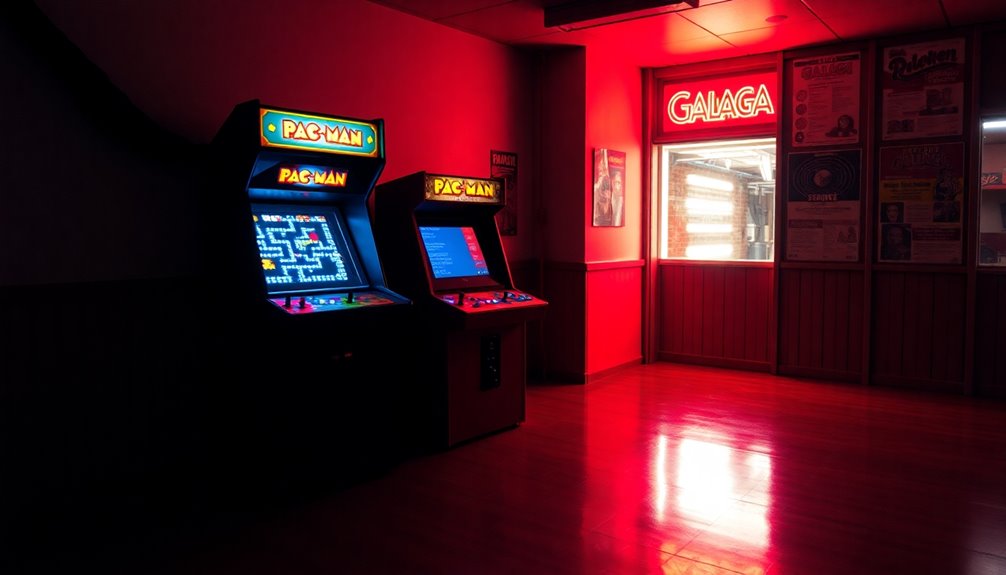Arcade games generate revenue primarily through gameplay fees, which typically range from $0.25 to $2.00 per play. There are also entry fees for unlimited gameplay, which significantly increase profits. In addition, arcades sell tokens, snacks, and merchandise to boost their income. Many games offer prizes to entice players to return and spend more money. Most customers, particularly teenagers and young adults, visit regularly and spend an average of $10 to $25 each visit. Strategic game selection and regular updates help keep players engaged. If you’re interested in learning more about how these factors contribute to profitability, stay tuned for additional insights. To maximize profits, arcade owners carefully choose and invest in the most profitable arcade games available. These games typically attract a large number of players, hold their interest, and promote repeat plays. By strategically placing these popular games throughout the arcade, owners can ensure a steady stream of revenue. Additionally, offering promotions and incentives for playing these games can further enhance their profitability.
Key Takeaways
- Arcade games generate income primarily through game plays, with prices ranging from $0.25 to $2.00 each.
- Offering entry fees for unlimited gameplay, typically between $5 and $20, boosts overall profits.
- Additional revenue streams include selling tokens, snacks, drinks, and merchandise to customers.
- Prize redemption systems encourage repeat visits by allowing players to exchange game credits for prizes.
- Regular updates and new game introductions maintain customer interest, driving higher financial returns.
Revenue Generation Strategies
Arcades have several smart strategies for generating revenue that go beyond just game plays. While you might think game plays alone drive income, they actually range from $0.25 to $2.00 each. Many arcades also charge entry fees for unlimited gameplay, typically between $5 and $20, which can greatly boost profits.
Additionally, creating an inviting atmosphere with diverse gaming options, similar to New England's diverse camping locations, enhances the overall experience and encourages longer visits.
To enhance revenue generation, arcades focus on additional income streams such as selling tokens, game credits, snacks, and merchandise. These options not only increase profitability during your visit but also promote repeat business.
Prize redemption systems play a vital role too; by offering enticing redemption prizes that range from $5 to $200, you're more likely to return for another try.
Hosting tournaments and events can draw in crowds and generate entry fees, while promotions and loyalty programs keep you coming back.
Finally, regularly updating the game selection with popular and engaging titles guarantees that you and other players stay interested and engaged, ultimately contributing to higher financial returns over time.
Customer Demographics and Spending

When you think about arcade customers, you might picture teenagers and young adults who make up the majority of the crowd.
Curiously, this demographic mirrors trends seen in other entertainment sectors, like celebrity social dynamics, where strong connections can influence spending habits.
Their spending habits reveal trends, like how much they typically shell out per visit and their frequency of trips.
Understanding these behaviors can help arcade owners tailor their offerings to maximize revenue, similar to how private paradises are designed to enhance celebrity retreats.
Demographic Segmentation Analysis
Understanding demographic segmentation is essential for arcade owners looking to maximize their revenue potential. By focusing on key demographic segments like teenagers aged 13-19 and young adults aged 20-30, you can tailor your offerings to match their preferences. These groups often engage with arcade games more frequently, leading to increased customer spending.
Additionally, leveraging community feedback can help identify the most lucrative options for game selection and pricing. On average, customers spend between $10 to $25 per visit, with many making 3 to 8 visits monthly. This frequency highlights the potential for long-term revenue, as the average customer lifetime value can range from $120 to $800.
Factors influencing spending include game costs, typically between $0.25 and $2.00, and in-arcade purchases like snacks and drinks priced between $1 and $3.
Incorporating effective prize redemption systems can further boost engagement among these demographic segments. By offering prizes that vary in value from $5 to $200 based on ticket redemption, you not only enhance the gaming experience but also encourage repeat visits.
Understanding these dynamics allows you to strategically enhance customer engagement and drive revenue growth in your arcade.
Spending Behavior Trends
While various factors influence spending behavior in arcades, customer demographics play a crucial role in shaping these trends. You'll notice that teenagers aged 13-19 and young adults aged 20-30 are the primary customers, often leading to higher revenue per customer. Their frequent visits, averaging between 3 to 8 times a month, markedly boost the arcade's overall income.
Additionally, the appeal of snacks, similar to how healthy dog snacks promote overall wellness for pets, can enhance the arcade experience and encourage more spending.
On average, you might spend between $10 to $25 per visit, but regulars can elevate their customer lifetime value to between $120 and $800. Game pricing and the allure of redemption games, where prizes can range from $5 to $200, greatly influence your spending patterns. These factors create an engaging entertainment experience that keeps you returning for more.
When you factor in additional in-arcade purchases like snacks and drinks, it's clear how these demographics can maximize revenue. The combination of engaging games and appealing prizes guarantees arcades can capitalize on your spending behavior, making each visit memorable while enhancing their financial success in the competitive entertainment landscape.
Profitability Metrics Explained

Arcades can be surprisingly profitable, but understanding their financial metrics is essential to grasping how they operate. One key metric is gross margin, which typically ranges from 25% to 45%. This figure indicates the difference between the revenue generated from game plays and the direct costs associated with operating arcade machines.
Additionally, incorporating popular games like pinball machines can greatly enhance customer engagement and revenue streams, as highlighted in best arcade machines for home game rooms.
Another important metric is net margins, which account for all expenses, including overhead. These margins usually fall between 5% and 15%, offering a clear view of overall profitability after fixed costs are deducted.
To stay afloat, arcades need to reach their breakeven point, where total revenue matches fixed costs. This often requires between 1,500 to 3,750 customers monthly, especially with fixed costs around $15,000.
Average spending per customer ranges from $10 to $25 during each visit, leading to an estimated revenue per customer of around $450 over their lifetime.
Monthly revenue can vary greatly, from about $5,000 for small rural setups to $40,000 for premium arcades boasting advanced technology and diverse game offerings.
Understanding these profitability metrics helps you appreciate the financial dynamics of running an arcade.
Key Operational Expenses

A variety of operational expenses can greatly impact an arcade's profitability. To keep your arcade thriving, it's imperative to understand the major costs you'll face. Here are three key operational expenses to take into account:
1. Rent: Often one of the largest fixed costs, rent can greatly affect your financial stability and profit margins. Choosing the right location is essential to balance visibility and affordability, as a well-placed arcade can attract more customers and increase revenue.
Additionally, having a solid budget can help you manage this expense effectively.
2. Staff Wages: Hiring and maintaining a skilled team is essential for customer service and overall operation. Staff wages are a recurring expense that you'll need to budget carefully to guarantee a smooth experience for your patrons, as having knowledgeable staff can enhance customer satisfaction and loyalty.
3. Maintenance Costs: Regular maintenance of your arcade machines is crucial to prevent breakdowns. The costs associated with repairs and parts can eat into your profitability if not managed proactively, making it important to allocate funds for this area in advance.
Additionally, don't forget about utilities, marketing efforts to attract customers, and administrative expenses like insurance.
Earnings Potential Overview

Understanding your arcade's operational expenses sets the stage for evaluating its earnings potential. Arcade games generate revenue primarily through game plays, with prices typically ranging from $0.25 to $2.00 per play. This pricing structure can lead to significant contributions to your overall earnings.
Monthly revenue for arcades can vary widely, from around $5,000 in small rural locations to an impressive $40,000 in urban venues that offer advanced technology and a diverse game selection. Additionally, implementing a holistic SEO approach can improve your online presence, attracting more customers to your arcade.
Customer spending plays an essential role, averaging between $10 to $25 per visit. Regular players often return multiple times a month, enhancing your income potential. Implementing a redemption system encourages repeat visits, as players can exchange tickets for enticing prizes. This strategy not only boosts revenue but also keeps your customers engaged and excited.
Moreover, the average customer lifetime value ranges between $120 and $800, showcasing the long-term financial benefits of retaining customers through enjoyable experiences.
Types of Arcade Business Models

Diverse business models drive the arcade industry, each offering unique opportunities for revenue generation. Understanding these models can help you optimize your investment and enhance customer engagement, especially in an era where increased focus on sustainability and responsible investing is influencing consumer behavior.
- Owner-Operated Arcades: As an owner, you choose and maintain the games, retaining 100% of the profits. If managed effectively, this model has incredible revenue potential.
- Route Operators: These operators place arcade machines in high-traffic locations, like malls or restaurants. They handle the investment and maintenance, often charging a fee or taking a percentage of earnings, which allows for passive income with strategic placements.
- Family Entertainment Centers: These venues combine arcade games with additional attractions, catering to families. The varied demographics influence game selection, enhancing customer engagement through themed events and loyalty programs.
Each arcade business model offers distinct advantages and challenges. By carefully considering your approach, whether it's an owner-operated arcade or partnering with route operators, you can maximize your revenue potential while keeping customers entertained and coming back for more.
Game Selection and Customer Engagement

Choosing the right games for your arcade can make all the difference in customer engagement and profitability. Focus on data-driven game selection rather than personal preference. This approach aligns your offerings with market demand and popular trends, ensuring you maximize revenue per visit.
A successful game room typically includes 60-70% redemption games, which engage customers through prize incentives, while 20-30% should be video games to appeal to a diverse audience.
When selecting games, consult with distributors to gain insights into performance metrics. This can help you choose highly profitable games that resonate with your target demographic. Additionally, regularly introducing new games to keep your collection novel is essential. Revitalizing your offerings every couple of years maintains customer interest and encourages repeat visits.
Effective customer engagement strategies, like hosting tournaments or themed nights, can further enhance the experience, driving more foot traffic and increasing overall spending.
Always consider factors such as game popularity, engagement levels, and potential revenue when curating your arcade's lineup. By focusing on these aspects, you can create a vibrant and profitable environment that keeps customers coming back for more.
Maintenance and Repair Considerations

Maintaining your arcade games is essential for keeping operations running smoothly and maximizing profits. Regular maintenance prevents breakdowns, which can greatly impact profitability by limiting revenue during peak times.
Additionally, understanding the importance of regular service, similar to fuel injection cleaning, can lead to better game performance and longevity.
Here's what you should focus on:
- Routine Maintenance: Establish a consistent schedule to guarantee operational efficiency. This helps identify low-performing games that might need replacement or upgrades.
- Quick Repairs: Minimize downtime by stocking commonly used parts and training your staff in basic repairs. Quick fixes can drastically improve your revenue potential.
- Monitoring Performance: Keep an eye on coin collection and game performance. This data lets you make informed decisions about machine placements and potential upgrades, optimizing your earnings.
Marketing and Community Engagement Strategies

Once your arcade games are running smoothly, you can shift focus to attracting customers through effective marketing and community engagement strategies. Developing a robust marketing plan that leverages social media and local advertising can notably boost your arcade's visibility, drawing in a diverse crowd.
Consider hosting promotional events or themed nights; these can create buzz and help establish a loyal customer base, ultimately increasing foot traffic and revenue. Additionally, luxury cruises provide exclusive amenities that could inspire unique gaming experiences or themed events within your arcade.
Engaging with the community is essential. Partnering with local businesses for joint promotions not only enhances visibility but can also lead to mutually beneficial marketing opportunities.
Don't overlook the power of customer feedback, especially during a soft opening. Gathering insights will allow you to make necessary adjustments, enhancing overall customer satisfaction and retention.
Additionally, implementing loyalty programs can encourage repeat visits, fostering long-term engagement. Offering incentives through ticket sales can keep customers coming back.
Frequently Asked Questions
Are Arcades Still Profitable?
Yes, arcades can still be profitable. If you choose a strategic location, offer diverse games, and engage your community, you can attract regular visitors, leading to substantial monthly revenues despite competition from online gaming.
What Is the Profit Margin on Arcade Games?
Think of a treasure chest: arcade games often yield profit margins between 25% to 45%. However, once you factor in all costs, net margins shrink to 5% to 15%, reflecting the game's true treasure.
What Arcade Games Made the Most Money?
You'll find that games like "Skee-Ball," "Claw Machines," and classic titles like "Pac-Man" generate substantial revenue. Additionally, multiplayer experiences and advanced tech games attract players, boosting earnings considerably in modern arcades.
How Do Money Making Games Make Money?
Money-making games generate revenue by charging you for each play, enticing you with ticket prizes, and boosting sales through snacks and drinks. Your spending adds up quickly, ensuring a profitable experience for the arcade.
Conclusion
In the world of arcade games, making money is like mastering a classic pinball machine: it takes skill, strategy, and a bit of luck. Just like how a well-timed flipper can send that silver ball soaring, leveraging the right customer engagement and game selection can boost your earnings. The balance between fun and profitability keeps players coming back for more, ensuring your arcade isn't just a fleeting thrill but a lasting destination for enjoyment and revenue.








